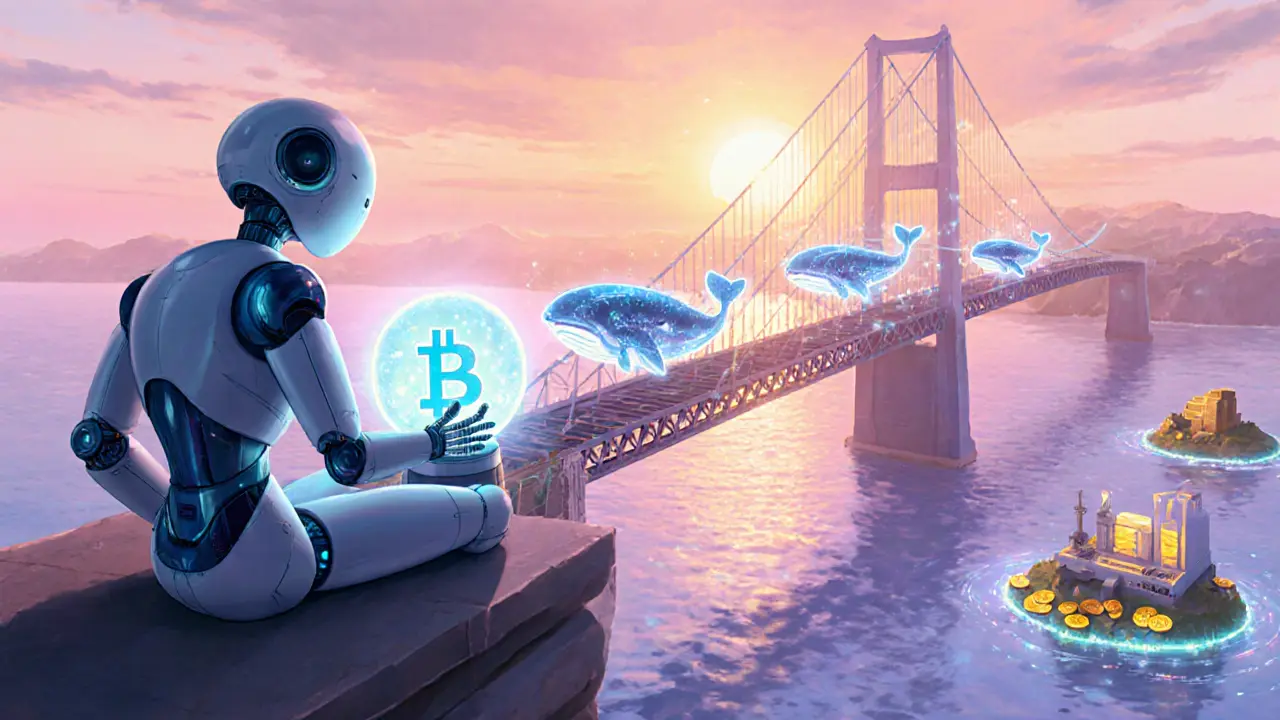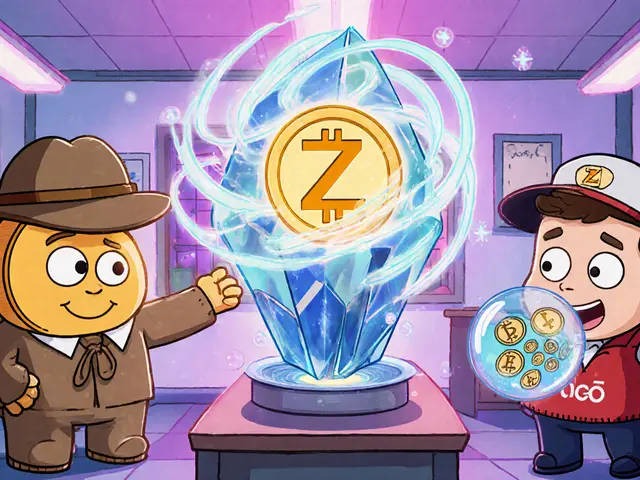Crypto Whale Value Calculator
Calculate Whale Thresholds
Whale Thresholds
Results
Enter values to see calculation results
When a wallet that holds thousands of Bitcoins suddenly pumps money into an exchange, the price often reacts as if a storm is rolling in. Those massive moves-known as crypto whale tracking-are the most visible on‑chain signals that traders watch for clues about the next market swing.
What Exactly Are Whale Deposits and Withdrawals?
Exchange whale deposits and withdrawals are the movement of large cryptocurrency amounts (typically 1,000+BTC or equivalent) between private wallets and centralized exchanges. A deposit signals that a whale is placing funds where they can be sold, while a withdrawal suggests the opposite-moving assets to cold storage or DeFi protocols.
How the Industry Defines a Whale
Definitions vary by coin. For Bitcoin, a whale holds at least 1,000BTC (about $68million at current prices). Ethereum whales usually own 10,000ETH (roughly $28million). These thresholds come from Glassnode a blockchain analytics firm that introduced the "Whale Size Subdivisions" metric in 2020. The same firm also splits whales into three bands-1,000‑10,000BTC, 10,001‑100,000BTC, and >100,000BTC-each showing distinct behavior patterns.
Key On‑Chain Metrics You Should Follow
Analytics platforms publish a handful of numbers that condense whale activity into digestible signals:
- Deposit/Withdrawal Volume Ratio: compares total BTC sent to exchanges versus taken out. Glassnode reported a ratio of 100.61%/16.5% in 2023, indicating net accumulation.
- Exchange Inflow Mean: average size of each deposit. A jump from the usual 0.7BTC to above 6BTC often precedes price drops.
- Bitcoin Accumulation Trend Score: a 0‑1 scale where values near 1 signal strong buying by large holders. The score peaked at 0.87 in Q32023.
- Whale Reshuffling: tracks balance shifts among the three whale size groups over a 30‑day window, revealing whether big players are moving funds between wallets.
Real‑World Market Impact
When whales dump assets on an exchange, the order book can become thin. Bitcoin.tax’s liquidity analysis shows that a $50million trade can swing price 5‑7% if the exchange’s depth is low. Conversely, when whales withdraw, buying pressure often eases, leading to price stabilization or modest gains.
Historical data backs this up. During the 2021 bull run, deposits peaked at 185,000BTC in November, right before the correction. In the 2022 bear market, withdrawals topped 500,000BTC between June and December, helping to cushion the decline.
Tools That Give You the Whale‑Watching Edge
Several platforms specialize in turning raw blockchain data into actionable alerts:
| Platform | Primary Focus | Alert Threshold |
|---|---|---|
| Glassnode | On‑chain metrics & AI predictions | Movements >$10M |
| Lookonchain | Wallet clustering & historical analysis | Deposits >500BTC |
| Nansen | Real‑time dashboards for DeFi + exchanges | Withdrawals >$15M |
| Santiment | Sentiment & on‑chain combined | Whale reshuffling events |
All these tools embed the same core process: they scan public ledgers, match known wallet clusters (often identified by Lookonchain which pioneered address clustering in 2018), then trigger alerts when thresholds are crossed.
Interpreting the Signals - Not All Moves Mean the Same Thing
Even with precise numbers, context matters. OneSafe.io points out the “paradox of market signals”: a large withdrawal could mean a whale is shifting to DeFi staking rather than preparing to sell. Meanwhile, a massive deposit might be a hedge against a pending ETF approval rather than a pre‑sell order.
Institutional whales behave differently. Coinbase Institutional reports that firms like BlackRock keep their exchange balances steady while buying via OTC desks, effectively dodging the price impact that a direct deposit would cause.
Community sentiment also adds a layer of interpretation. A September2023 Reddit poll showed 68% of respondents read withdrawals as bullish, while 22% saw them as prep for coordinated selling.

Regulatory Landscape and Market Manipulation Risks
The SEC’s March2023 guidance warned that coordinated whale movements could be viewed as market manipulation if they create a false impression of supply‑demand balance. Enforcement remains tricky because on‑chain data is public, yet intent is hard to prove. Nonetheless, exchanges are tightening KYC/AML checks to flag unusually large flows.
What’s Coming Next for Whale Tracking?
Artificial‑intelligence models are already in the mix. Glassnode’s Whale Behavior Prediction Algorithm, unveiled in August2023, blends deposit/withdrawal patterns with macro‑economic indicators and claims 68% accuracy for a 7‑day price forecast.
Cross‑chain bridges add complexity. Arkham Intelligence notes that about 12% of whale moves now span multiple networks-think a BTC whale sending funds to an ETH‑based DeFi protocol via a bridge. Future tools will need to aggregate data from Bitcoin, Ethereum, and emerging L2s to give a full picture.
Finally, the rise of DeFi yield farming means whales can earn interest without ever touching an exchange. OneSafe.io observed a wave of ETH withdrawals from Kraken that landed directly in staking contracts, suggesting a shift from “sell‑or‑hold” to “earn‑and‑hold.”
Quick Checklist for Traders Monitoring Whale Activity
- Watch the Deposit/Withdrawal Volume Ratio-values >100% often precede bull runs.
- Set alerts for deposits larger than 5BTC (or $100M equivalent) on your preferred platform.
- Combine on‑chain data with sentiment metrics from Reddit or Twitter for richer context.
- Consider the whale’s size band; >10,000BTC whales tend to distribute, while 1,000‑10,000BTC whales accumulate.
- Stay aware of regulatory news; sudden spikes around SEC rulings may signal coordinated moves.
Frequently Asked Questions
How do I know if a wallet is a whale?
Most analytics platforms label a wallet as a whale when it holds at least 1,000BTC (or the equivalent in another coin). The threshold is based on the market impact that such a balance can have when moved to an exchange.
Do whale withdrawals always mean the market will go up?
Not necessarily. Withdrawals can signal that a large holder is moving assets to a cold wallet, to a DeFi protocol, or simply rebalancing. Context-such as concurrent market sentiment and other on‑chain metrics-determines the likely direction.
Which platforms give real‑time whale alerts?
Glassnode, Lookonchain, Nansen, and Santiment all provide real‑time dashboards and push notifications for movements exceeding preset thresholds (usually $10‑15million).
Can I trade based solely on whale activity?
Whale data is a powerful piece of the puzzle, but relying on it alone is risky. Combine it with technical analysis, macro news, and risk management to avoid false signals.
How might regulation affect whale movements?
If regulators deem coordinated large‑scale deposits as market manipulation, exchanges could impose stricter reporting requirements, potentially slowing down the speed at which whales can act.




18 Comments
Shrey Mishra
The sheer magnitude of whale movements underscores the fragile nature of market confidence; when a single entity shifts billions, the ripple feels almost theatrical, as if the market itself were a stage for drama beyond ordinary traders' reach.
Kyla MacLaren
i totally get that, its wack how one big wallet can mess up everything lol
but i think staying chill and watching the charts is the real key.
Linda Campbell
It is incumbent upon us, as vigilant stewards of this financial frontier, to recognise that the ostentatious maneuvers of so‑called “whales” often betray a deeper sovereign agenda aimed at consolidating power within a select few.
John Beaver
Look, the data from Glassnode shows that when deposits top 5BTC avg, the price dip averages 2‑3% within 24h.
That's a useful rule of thumb for anyone wantin' to hedge.
EDMOND FAILL
Even without the fancy charts, you can see the pattern: big on‑chain moves tend to precede the next volatility swing, so keep an eye on those alerts.
Jennifer Bursey
When you dive into the on‑chain ecosystem, several interlocking mechanisms emerge that collectively drive price dynamics.
First, the Deposit/Withdrawal Volume Ratio acts as a sentiment barometer, quantifying net inflows versus outflows.
Second, the Exchange Inflow Mean provides granularity on average deposit size, which historically spikes before corrections.
Third, the Accumulation Trend Score, calibrated on a 0‑1 scale, signals when large holders are net buying.
Moreover, Whale Reshuffling patterns reveal intra‑band migrations that can foreshadow strategic repositioning.
Cross‑chain bridging adds another layer of complexity, as assets can be funneled from Bitcoin into Ethereum DeFi hubs, diluting the direct impact on any single ledger.
Regulatory scrutiny, especially post‑SEC guidance, injects a risk premium that can mute the immediate price effect of large moves.
In practice, blending these metrics with macro‑economic data-like CPI releases-sharpens predictive accuracy.
Platforms such as Glassnode, Lookonchain, Nansen, and Santiment each specialize in slicing this data differently, offering real‑time alerts for movements exceeding $10‑15M.
Crucially, context matters: a 50 BTC deposit might be a hedge against an ETF decision rather than a sell signal.
Conversely, a sizable withdrawal could indicate a migration to staking protocols, implying a hold‑and‑earn strategy.
Thus, traders should not treat whale activity as a standalone indicator but as a component of a broader analytic tapestry.
Maureen Ruiz-Sundstrom
Honestly, most of these whale metrics feel like just fancy numbers that seasoned traders already intuit. They rarely add a decisive edge.
Kevin Duffy
😄 Yeah, the numbers can be a bit much, but they’re handy for the newbies! Keep your eyes on the alerts and you’ll be fine.
Tayla Williams
It is morally reprehensible that a privileged minority can manipulate market sentiment for personal profit, thereby endangering the financial wellbeing of the broader public.
Brian Elliot
While the ethical concerns are valid, we must also recognise that market efficiency often relies on participants acting on information, even if that information stems from large holders. Balance is key.
Marques Validus
Whoa, here we go again with the same old whale hype, as if their every move is the gospel truth-newsflash: markets are driven by millions, not just a handful of overinflated egos.
Mitch Graci
Oh absolutely!!! The whales are the only ones who actually KNOW what they're doing!!! 🙄
Jazmin Duthie
Whale alerts are just noise.
Michael Grima
Look, the whole whale narrative is a bit overblown. Sure, a massive deposit can jiggle the price, but seasoned traders already factor in liquidity depth. In most cases, those big moves are just routine rebalancing. So, don't let the headlines drive your decisions.
Michael Bagryantsev
I hear the concerns, and I think it's wise to stay grounded. Use whale data as a checkpoint, not a crystal ball.
Maria Rita
Remember, every chart pattern tells a story-your job is to read it, stay disciplined, and keep your risk low. You've got this!
Jordann Vierii
Let's harness the data, keep the community informed, and push forward with confidence-together we can navigate any market wave.
Lesley DeBow
The existential weight of whale movements reminds us that markets are but a fleeting reflection of collective belief; yet, we must act with humility.